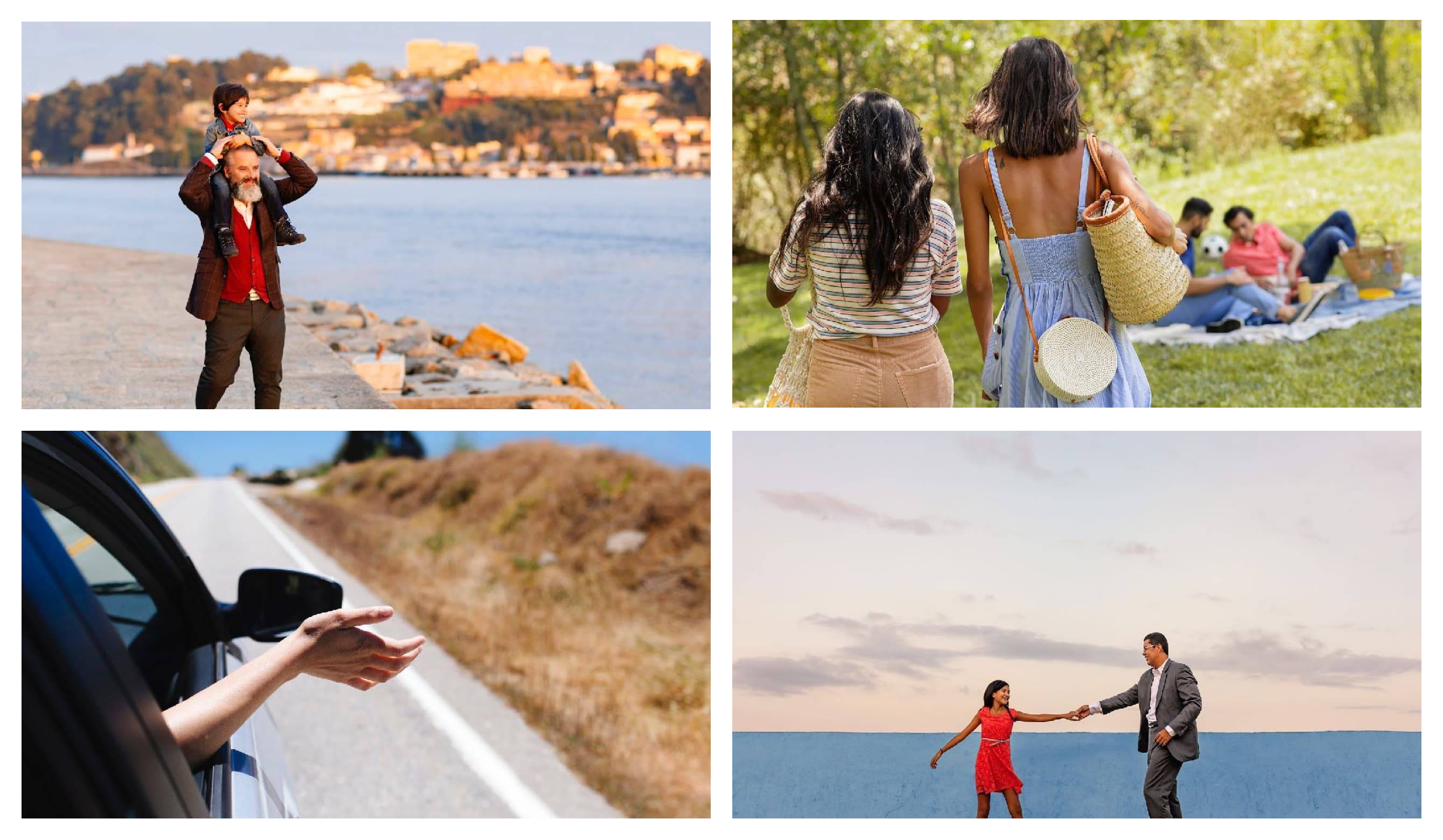Photography
Our photography inspires our audience of young and old, rich and poor, customers and partners, local and global. Clarification of how Uber works is unnecessary. We build on how it feels to move from motivation at point A to the emotional payoff arriving at point B.
How we express the brand in photography
- Interactions : Express Movement
- Compositions: Open with negative space
- Casting: People are relatable
- Lighting and color: Appears natural
- Locations: Simplified while showing local character
Interactions
Goal: Capture and showcase how movement connects people, places and communities.
- Subjects are in lively moments full of energy and conveying a positive emotional impact
- Individuals or groups of people should feel ‘caught in the moment’ and unaware of the camera, as if the viewer is unobtrusively brought in to an intimate moment
- Settings aren’t just backdrops, subjects interact with their environment (i.e. buying ice cream from a local vendor, checking out street murals, participating in public activity)
- Highlight how Uber brings people together, enhancing community and the vibrant, shared life within cities
- Motion should further the plotline
- No forced or posed-looking expressions or actions
Express movement

Composition
Goal: Bold use of open space allows for an inviting expression of optimism.
- Use of negative space in the image moves the eye quickly to the main focus
- Include negative space around the subject to allow for the placement of additional design elements such as typography
- Note that rule of thirds or leading line compositions can be great ways to create open space
- Highlight the subject and the activity, movement, connection they are experiencing by keeping composition simple.
- Coordinate locations, backgrounds, and wardrobe to establish a visual simplicity
- Simplify the scene rather than overusing shallow depth of field
Open with negative space


Casting
Goal: Feature a wide range of people (age, race, gender, sexual orientation, ability, class, body type, etc.) that reflect our broad audience of riders and drivers around the world.
- Subjects are not intended to look like professional models
- Subjects are ideally real drivers, riders, and employees. If none can be found, cast models that look like real riders, drivers, and employees
- Dress, hair, and makeup should all feel authentic to the subject’s area and itself reflect diversity the area’s diversity
- Cast people with expressive and outgoing personalities
People are relatable


Lighting & Color
Goal: Create an inviting and relatable feel with realistic lighting and color.
- Lighting appears like natural light
- No harsh highlights or shadows, particularly on people’s faces
- Images have high dynamic range—highlights and shadows hold shape and detail; skys, tree edges, etc. are not blown out; images hold an edge if placed on white
- Images should look naturally white balanced, not stylized
- Wardrobe and location support simple and vibrant use of color on people and vehicles to draw the eye to the main focus
- Don’t count on post-processing to add or enhance color, include pops of color in planning photos
- Neither lighting nor color processing are overly low-key, overly dramatic, or create a negative association
Appears natural

Locations
Goal: Capture our global presence and localized nature by zeroing in on colorful, simple, eye-catching locations.
- Select locations for unique appearance, character, and feel—background colors are a plus. Yet locations do not need to be identifiable, and may seem familiar to people from a range of places (i.e. Milan can look like Madrid, but Toronto shouldn’t look like a generic urbanscape)
- Do not include monuments that a tourist would pose in front of
- Reflect connection to urban mobility
- Scenes should capture the least amount of elements to convey the story
- Avoid cluttered or visually busy elements that distract from the subject
- Subjects should be engaging with their environment, not just posing in front of it
- Avoid single people in an empty landscape, unless warranted by a specific story
Simplified local character

Shot List
This is a rough breakdown of the types of shots that should be captured when creating a shot list for a shoot.

- Hero 20%Hero shots focus on the main person or product from the story and are shot in context, not in studio.
- Lifestyle 50%We focus on the opportunities and the connections people make, instead of showcasing the literal journey from point A to B.

- Lifestyle w/ product 10%When product is included it should take up 20% or less of the space of the total composition.
- Textural 20%These are abstract images that supplement the overall story. The goal is to provide an alternative viewpoint to expand on the main story.
Photography Guidance
Things to avoid:
- Shooting from extreme or unnatural angles--eye level is good.
- Blown out skies, hair, tree edges etc.— images need to hold tone on white.
- Cluttered and complex compositions that distract from the main hero.
- Harsh shadows or lighting on the subject, along with reflections and blur that complicate the photo
- Forcing the talent to pose in unnatural ways, or express emotion that is not true to the narrative i.e. a driver should not be engaged with the photographer or on their phone while operating a vehicle

- Avoid shooting through foreground elements or forced framing.
- Avoid static moments. Where people are unengaged with each other.
- Avoid blown out areas so image holds an edge on white.

- Avoid shooting drivers while driving.
- Avoid distracting reflections.
- Avoid overly dramatic lighting and excessive lens flare.

- Avoid unnaturally colored lighting.
- Avoid backgrounds that distract from the subject.
- Avoid low or unnatural angles.
Photography Applications
Internal screens



Website

Photography Summary
Capture movement
Keep compositions open and inviting
Casting that reflect the diversity of our users